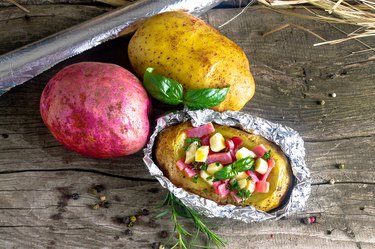
Potatoes are as American as apple pie, and on average, Americans eat about 110 pounds of them a year, according to Northern Plains Potatoes. Baking potatoes in foil is one of many preparations for these potassium-rich root vegetables. Pair them with fiber- and protein-rich foods for a healthy meal.
Baked Potatoes in Foil
Video of the Day
Baking potatoes in foil helps keep in some of the moisture so the potatoes don't dry out. Because no one likes a chalky, dry potato. All you need is some foil and either a range oven or a toaster oven.
Video of the Day
1. Preheat the oven to 400 degrees Fahrenheit.
2. Wash the potatoes well. Potatoes grow underground, which means they're covered in dirt. Much of that has been removed before they make it to store shelves, but it's always a good idea to give them a good scrubbing before wrapping them in foil.
Washing all vegetables can lower the risk of foodborne illness, according to the Centers for Disease Control and Prevention, although baking the potatoes will destroy most bacteria. Scrub the potatoes under warm water with a potato brush, coarse sponge or cloth.
Tip
Take a look at your potatoes before you wash them, especially if they have been stored a long time. Potatoes that have sprouted or turned green can cause toxicity with symptoms that include vomiting, abdominal pain and diarrhea, according to the National Capital Poison Center. It's best to toss these and buy a fresh batch.
3. Dry the potatoes and prick them all over with the tines of a fork. This allows steam to escape, and prevents a potential explosion. Completely enclose the potatoes in tin foil so that no skin is exposed.
4. Place the potatoes in foil packets in the oven on the middle rack. Bake for 45 to 60 minutes, depending on the size of the potatoes. Smaller potatoes will cook faster than larger potatoes. Test for doneness by carefully unwrapping one to expose some skin and piercing it to the middle with a fork. If you meet resistance, it is not fully cooked yet.
Read more: 16 Diet-Friendly Healthful Carbs
Healthy Baked Potato Recipes
If you love baked potatoes but you also want to eat healthier, you'll be disappointed to hear that many health and nutrition experts advise eating them sparingly. Although they are a good source of many vitamins and minerals, they are also high in carbohydrates, particularly the kind that the body digests rapidly. This causes blood sugar and insulin levels to rise quickly, then fall precipitously.
These dramatic fluctuations in blood sugar can cause you to feel hungry again soon after eating. According to Harvard T.H. Chan School of Public Health, white potatoes have effects on blood sugar similar to soda and candy, and it warns that eating a lot of potatoes and other rapidly digested foods can increase the risk of obesity, diabetes and heart disease.
That doesn't mean you have to strictly avoid them, but they shouldn't be a regular feature of your diet. When you do make a baked potato, don't do further damage by adding common accoutrements like melted cheese and bacon, which are high in saturated fat.
Instead, drizzle your baked potato with a little heart-healthy olive oil and top with our Steamed Broccoli Florets, grilled chicken and a little grated Parmesan or a few crumbs of feta cheese. The extra fiber from the broccoli, the protein from the chicken and the fats from the olive oil can mitigate the potato's effects on your blood sugar.
- Northern Plains Potatoes: "Potato Fun Facts"
- Centers for Disease Control and Prevention: "Fruit and Vegetable Safety"
- National Capital Poison Center: "Are Sprouted Potatoes Safe to Eat?"
- USDA FoodData Central: "Potatoes, Russet, Flesh and Skin, Baked"
- Harvard T.H. Chan School of Public Health: "The Problem With Potatoes"
- Academy of Nutrition and Dietetics: "What Is Glycemic Index?"